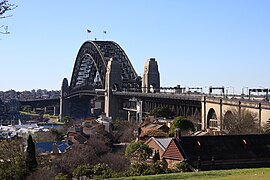Dawes Point, New South Wales
|
Dawes Point Sydney, New South Wales |
|||||||||||||
|---|---|---|---|---|---|---|---|---|---|---|---|---|---|

Sydney Harbour Bridge, viewed from Observatory Hill
|
|||||||||||||
| Population | 544 (2011 census) | ||||||||||||
| • Density | 5,400/km2 (14,000/sq mi) | ||||||||||||
| Postcode(s) | 2000 | ||||||||||||
| Area | 0.1 km2 (0.0 sq mi) | ||||||||||||
| Location | 1 km (1 mi) north of Sydney CBD | ||||||||||||
| LGA(s) | City of Sydney | ||||||||||||
| Parish | St. Philip | ||||||||||||
| State electorate(s) | Sydney | ||||||||||||
| Federal Division(s) | Sydney | ||||||||||||
|
|||||||||||||
Dawes Point is a suburb of the City of Sydney, in the state of New South Wales, Australia. Dawes Point is located on the north-western edge of the Sydney central business district, at the southern end of Sydney Harbour Bridge, adjacent to The Rocks. Sections of Dawes Point have been included as part of The Rocks area in the past and some residents and businesses still use it in their address.
The area was originally known by the Aboriginal names of Tar-ra and Tullagalla. This was later changed to Point Maskelyne in honour of Reverend Dr Nevil Maskelyne, British Astronomer Royal. He sent out the first astronomical instruments which were established at the point in the country's first observatory, by Lieutenant William Dawes (1762-1836), astronomer with the First Fleet. The point was renamed in honour of Dawes.
It was also the site of the first guns mounted in Sydney by Dawes in 1788, contained Sydney's first cemetery and later Dawes Point Battery. Walsh Bay was the site of Sydney's port facilities. The wharves were converted to apartments, theatres, restaurants, cafes and a hotel.
By the 1840s, the people of Dawes Point and Millers Point were a maritime community in which rich and poor mixed more than elsewhere in Sydney. Wharf owners and traders lived and worked beside those who worked on the wharves and bond stores, as well as those who arrived and left on ships. Only two of the merchant houses, built by and for the early wharf owners, survive. One is Walker's 50-foot wide villa built around 1825 and now part of Milton Terrace at 7-9 Lower Fort Street; the other is the home and offices of Edwards and Hunter, built in 1833 above their wharves which is where the Wharf Theatre now stands.
The fortunes of Dawes Point and Millers Point fluctuated more than elsewhere in Sydney. Mostly prosperous in its early years, the area was less desirable by the 1890s, and in 1900 there was a catastrophic event that led to a complete reshaping of Millers Point.
...
Wikipedia
